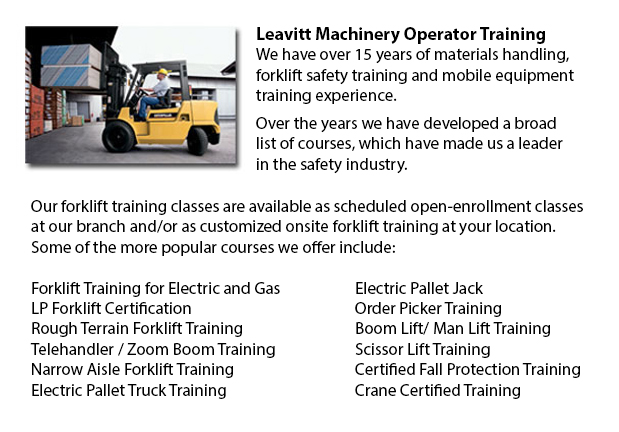
Forklift Training Schools Kamloops - Why People Who Utilize A Forklift Have to Take Whatever Of Our Forklift Training Schools
Are you searching for a job as a driver of a forklift? Our regulatory-compliant mobile equipment operator training provides instruction in kinds of forklifts, pre-shift inspection, fuel types and handling of fuels, and safe operation of a lift truck. Practical, hands-on training helps people participating in obtaining fundamental operational skills. Course content consists of current rules governing the utilization of lift trucks. Our proven forklift Schools are designed to offer training on these types of trucks: counterbalanced forklift, powered pallet trucks and narrow isle forklift.
Do not raise or lower the fork when the lift truck is traveling. A load must not extend over the backrest due to the danger of the load sliding back toward the operator. Inspect for overhead obstacles and make certain there is plenty of clearance prior to raising a load. Stay away from overhead power lines. When the load is lifted straight up, tilt it slightly back.
The lift truck is less steady if a load is in a raised position. Make certain that no one ever walks under the elevated fork. The operator should not leave the forklift when the load is raised.
The forks should be level when handling pallets, and high enough to extend all the way into and beneath the load. The width of the forks should provide equal distribution of weight.
Prior to loading or unloading the truck, set the brakes and chock the wheels. Floors must be strong enough to support the weight of the load and the forklift combined. Fixed jacks could be installed to be able to support a semi-trailer that is not coupled to a tractor. The height of the entrance door must clear the height of the forklift by a minimum of 5 cm. Mark edges of rail cars, ramps or docks and avoid them.
-
Forklift Training Course Kamloops
Forklift Training Course Kamloops - CSA and OSHA establish criteria for forklift safety training that meets current standards and regulations. Anybody planning to use a forklift is needed to successfully complete safety training prior to utilizing an... More -
Forklift Training Program Kamloops
Forklift Training Program Kamloops - The forklift is a common powered industrial vehicle which is in wide use these days. They are occasionally called lift trucks, jitneys or hi los. A departments store will use the forklift in order to unload and lo... More -
Aerial Lift Training Kamloops
Aerial Lift Training Kamloops - The mechanized access platform known as an aerial work platform is a machinery which provides access to places that are otherwise inaccessible to people and other machine. Likewise called an elevating work platform or... More -
Forklift Training School Kamloops
Forklift Training School Kamloops - Forklift Training School - CSA and OSHA establish criteria for forklift safety training which meets existing standards and regulations. Anybody planning to use a forklift is needed to successfully complete safety t... More -
Heavy Equipment Training Courses Kamloops
Heavy Equipment Training Courses Kamloops - When choosing a heavy equipment operator course, the initial step must be to determine the capacity in which you would be working with heavy machines. You could find the correct course to teach you how to o... More -
Heavy Equipment Training School Kamloops
Heavy Equipment Training School Kamloops - HEO or also known as the heavy equipment operator courses would provide you with the skills and knowledge required in order to enter the workforce as an entry level heavy machine operator. In this 12 week co... More -
Telehandler Operator Training Kamloops
Telehandler Operator Training Kamloops - Telescopic handler Forklifts or telehandler forklifts are common industrial equipment found in numerous construction industry environment. The telehandler is a helpful machinery and makes for a valuable tool w... More -
Telehandler License Kamloops
Telehandler License Kamloops - A telehandler or telescopic handler is a machine which is frequently utilized in agricultural and industrial applications. It has a similar appearance to a forklift and even works in a similar manner, though, the teleha... More

Forklift Training Kamloops
TOLL FREE: 1-888-254-6157
Kamloops, British Columbia
forklifttrainingkamloops.com
Email Us
About Us


